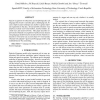26 search results - page 3 / 6 » Modeling Morphologically Rich Languages Using Split Words an... |
ACL
2011
12 years 8 months ago
2011
This paper extends the training and tuning regime for phrase-based statistical machine translation to obtain fluent translations into morphologically complex languages (we build ...
ICASSP
2009
IEEE
13 years 8 months ago
2009
IEEE
Speech recognition of inflectional and morphologically rich languages like Czech is currently quite a challenging task, because simple n-gram techniques are unable to capture impo...
IJCNLP
2005
Springer
13 years 10 months ago
2005
Springer
In this paper, we present an empirical study that utilizes morph-syntactical information to improve translation quality. With three kinds of language pairs matched according to mor...
CORR
2002
Springer
13 years 4 months ago
2002
Springer
We present two methods for unsupervised segmentation of words into morphemelike units. The model utilized is especially suited for languages with a rich morphology, such as Finnis...
CLEF
2009
Springer
13 years 5 months ago
2009
Springer
In biological sequence processing, Multiple Sequence Alignment (MSA) techniques capture information about long-distance dependencies and the three-dimensional structure of protein ...

